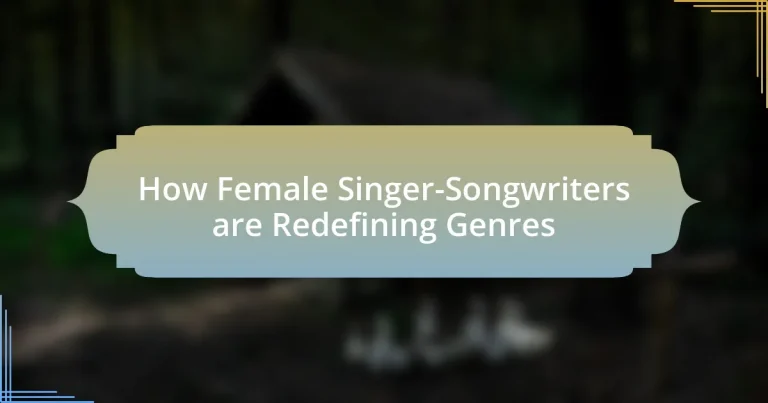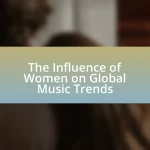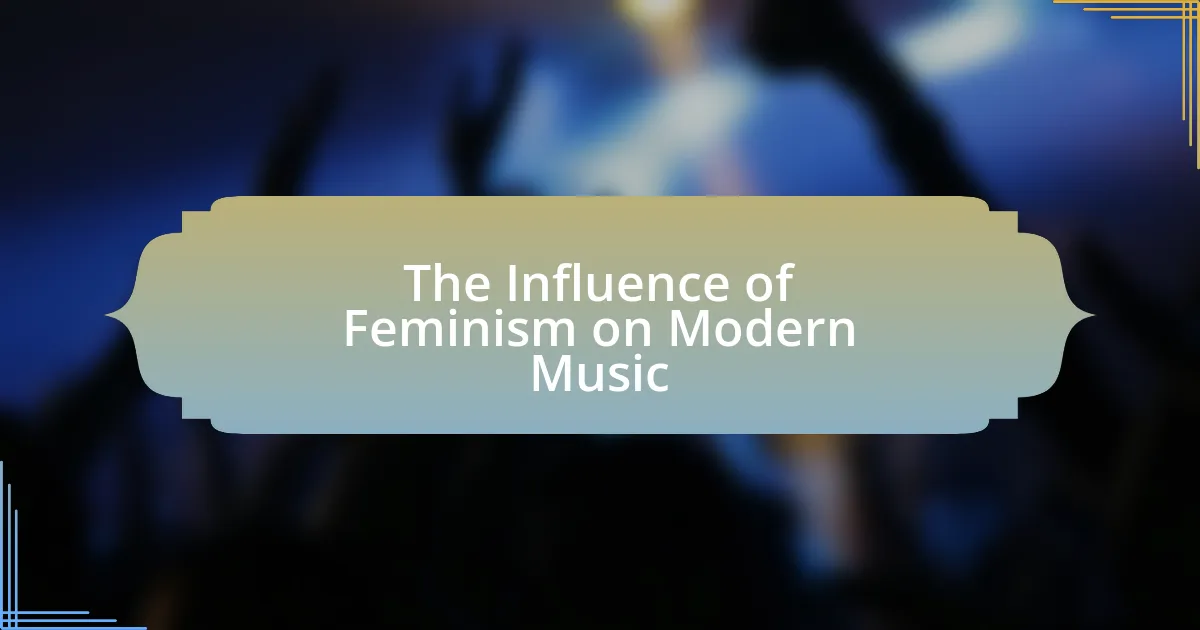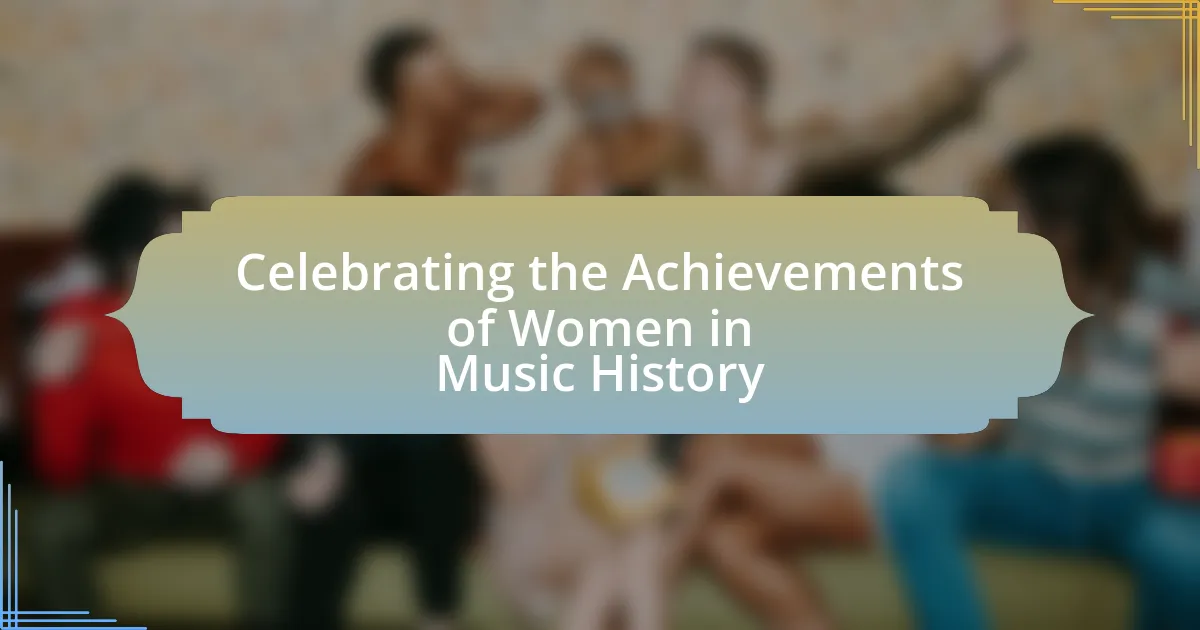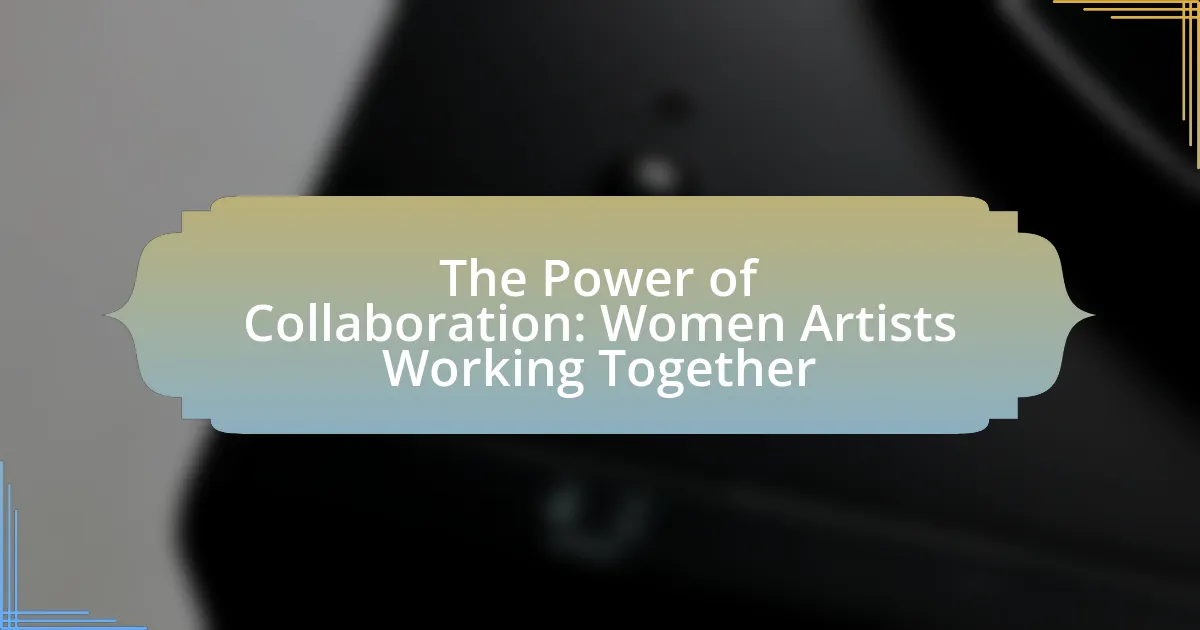Female singer-songwriters are significantly redefining music genres by blending diverse styles and incorporating personal narratives into their work. This article explores how artists like Billie Eilish and Taylor Swift challenge traditional genre boundaries, influence lyrical content, and address social issues through their music. It examines the impact of their personal experiences on their creative expression, the barriers they face in the industry, and the importance of their presence in promoting gender equality. Additionally, the article highlights notable examples of female artists reshaping genres and discusses future trends and strategies for enhancing visibility in the music landscape.
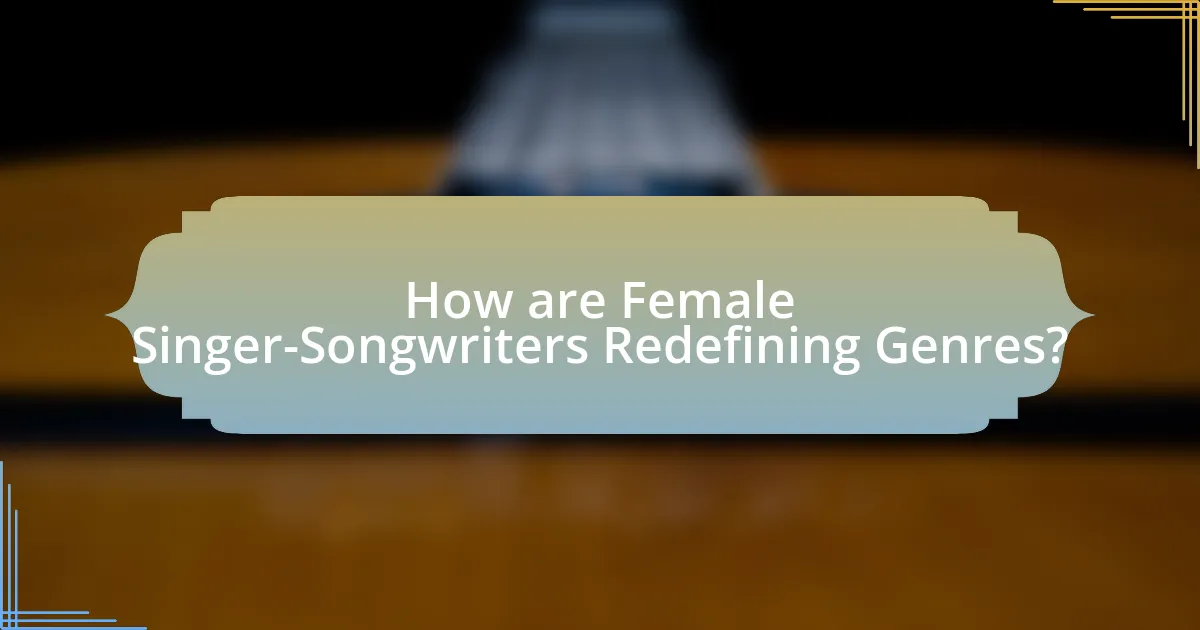
How are Female Singer-Songwriters Redefining Genres?
Female singer-songwriters are redefining genres by blending diverse musical styles and incorporating personal narratives into their work. This innovative approach allows them to challenge traditional genre boundaries, creating hybrid sounds that resonate with a broader audience. For instance, artists like Billie Eilish merge pop with electronic and indie influences, while Taylor Swift has transitioned from country to pop and alternative, showcasing versatility and genre fluidity. Their unique storytelling often addresses social issues, personal experiences, and emotional depth, further distinguishing their contributions. This shift not only expands the sonic landscape but also empowers other artists to explore and redefine their own musical identities.
What impact do female singer-songwriters have on music genres?
Female singer-songwriters significantly influence music genres by introducing diverse perspectives and innovative styles. Their contributions have led to the emergence of new subgenres and the blending of existing ones, as seen in the rise of indie pop and folk-rock, where artists like Joni Mitchell and Fiona Apple have redefined lyrical storytelling. Additionally, studies show that female artists often challenge traditional gender roles within music, promoting themes of empowerment and vulnerability, which resonate across various genres. For instance, the success of Taylor Swift in country and pop illustrates how female singer-songwriters can cross genre boundaries while maintaining commercial viability, thereby reshaping industry standards and audience expectations.
How do their personal experiences shape their musical styles?
Personal experiences significantly shape the musical styles of female singer-songwriters by influencing their lyrical content, emotional expression, and genre experimentation. For instance, artists like Taylor Swift draw from personal relationships and life events, which results in relatable storytelling that resonates with listeners. Similarly, artists such as Fiona Apple incorporate their struggles with mental health and personal trauma into their music, creating a raw and authentic sound that challenges conventional genre boundaries. This connection between personal narrative and musical expression not only defines their unique styles but also allows them to redefine genres by blending elements from various musical traditions, thus expanding the scope of contemporary music.
What genres are most influenced by female singer-songwriters?
Female singer-songwriters have significantly influenced genres such as pop, folk, rock, and country. These genres have seen a transformation in lyrical content, emotional depth, and musical structure due to the contributions of artists like Joni Mitchell in folk, Alanis Morissette in rock, and Taylor Swift in pop and country. For instance, Joni Mitchell’s introspective songwriting has shaped the folk genre, while Taylor Swift’s narrative-driven lyrics have redefined pop and country music, leading to a blending of styles that emphasizes personal storytelling.
Why is the presence of female singer-songwriters important in the music industry?
The presence of female singer-songwriters is important in the music industry because they bring diverse perspectives and experiences that enrich the artistic landscape. Female artists often challenge traditional gender roles and stereotypes, leading to a broader representation of themes and narratives in music. For instance, studies show that songs written by women tend to address issues such as empowerment, identity, and social justice, which resonate with a wide audience. Additionally, the rise of female singer-songwriters has contributed to increased visibility and opportunities for women in a historically male-dominated industry, fostering a more inclusive environment. This shift is evidenced by the growing number of female artists achieving commercial success and critical acclaim, such as Taylor Swift and Billie Eilish, who have both redefined genre boundaries and influenced contemporary music trends.
How do they challenge traditional gender roles in music?
Female singer-songwriters challenge traditional gender roles in music by asserting their autonomy and expressing diverse narratives that defy stereotypes. They often address themes such as empowerment, sexuality, and emotional complexity, which contrast with conventional portrayals of women in the industry. For instance, artists like Taylor Swift and Billie Eilish have utilized their platforms to discuss personal experiences and societal issues, thereby reshaping the expectations of female artists. This shift is evidenced by the increasing presence of women in songwriting and production roles, which historically have been male-dominated, highlighting a broader movement towards gender equality in the music industry.
What barriers have they overcome to gain recognition?
Female singer-songwriters have overcome significant barriers such as gender bias, lack of representation, and industry gatekeeping to gain recognition. Historically, the music industry has favored male artists, leading to fewer opportunities for women to showcase their talents. For instance, a study by the Annenberg Inclusion Initiative found that only 22.4% of artists on the Billboard Hot 100 from 2012 to 2019 were women, highlighting the gender disparity. Additionally, female artists often face challenges in being taken seriously as songwriters, with many being relegated to roles as performers rather than creators. By challenging these norms and gaining visibility through social media platforms and independent music scenes, female singer-songwriters have successfully carved out their space in the industry, leading to increased recognition and influence in various genres.
What are some notable examples of female singer-songwriters redefining genres?
Notable examples of female singer-songwriters redefining genres include Taylor Swift, Billie Eilish, and Janelle Monáe. Taylor Swift transitioned from country to pop and indie folk, showcasing her versatility and influencing genre boundaries with albums like “1989” and “Folklore.” Billie Eilish has redefined pop music with her unique blend of electronic, alternative, and indie influences, particularly evident in her album “When We All Fall Asleep, Where Do We Go?” Janelle Monáe merges R&B, funk, and hip-hop, challenging traditional genre classifications with her concept albums like “Dirty Computer.” These artists exemplify how female singer-songwriters are reshaping musical landscapes and expanding genre definitions.
How has Taylor Swift influenced country and pop music?
Taylor Swift has significantly influenced both country and pop music by blending genres and redefining lyrical storytelling. Her early work, characterized by traditional country elements, showcased personal narratives that resonated with a wide audience, leading to her first major success with the album “Fearless,” which won the Grammy for Album of the Year in 2010. As she transitioned to pop with “1989,” she not only achieved commercial success but also set a precedent for genre fluidity, as evidenced by the album’s multiple chart-topping hits and its influence on subsequent artists. Swift’s ability to cross genres has encouraged other female singer-songwriters to explore and merge different musical styles, thereby reshaping the landscape of contemporary music.
What role does Billie Eilish play in the evolution of pop music?
Billie Eilish plays a transformative role in the evolution of pop music by introducing a unique blend of vulnerability and authenticity in her songwriting and production. Her minimalist sound, characterized by subdued beats and intimate vocals, contrasts sharply with the polished, high-energy productions typical of mainstream pop. This shift has influenced a new generation of artists to embrace a more personal and experimental approach to music. Eilish’s success, exemplified by her multiple Grammy wins and chart-topping hits, demonstrates the commercial viability of this new style, encouraging the industry to prioritize emotional depth and artistic integrity over conventional pop formulas.
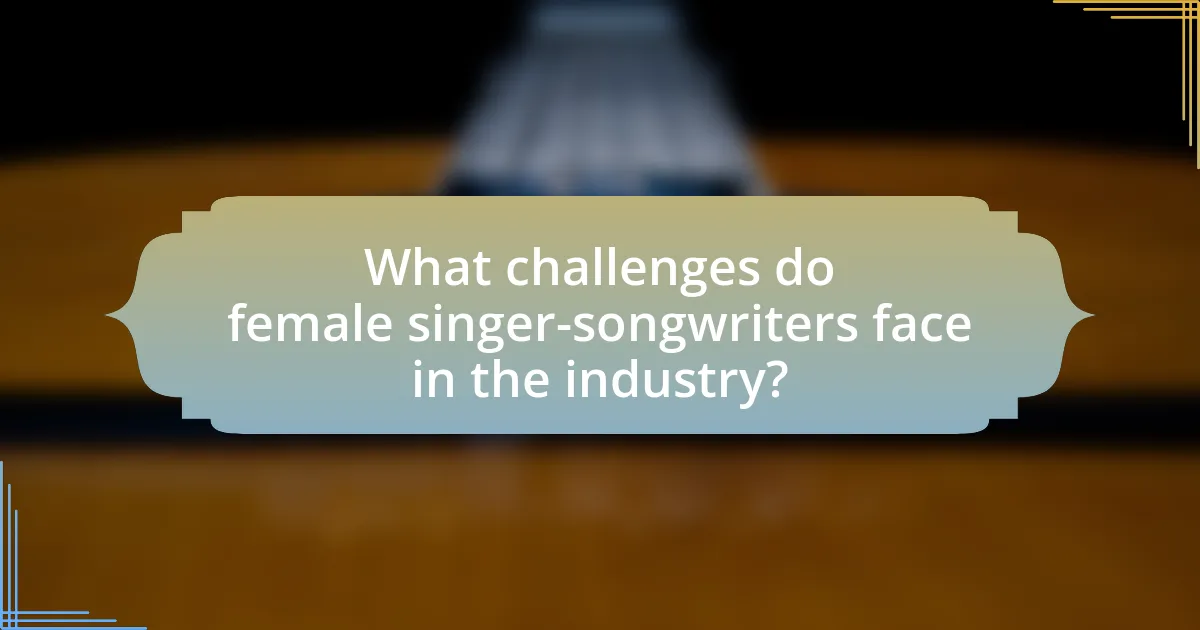
What challenges do female singer-songwriters face in the industry?
Female singer-songwriters face significant challenges in the music industry, including gender bias, lack of representation, and limited access to resources. Gender bias manifests in the form of stereotypes that often undermine their artistic credibility and marketability. According to a 2020 study by the Annenberg Inclusion Initiative, only 22.4% of artists on the Billboard Hot 100 were women, highlighting the underrepresentation of female artists. Additionally, female singer-songwriters frequently encounter difficulties in securing funding and support for their projects, as industry gatekeepers often favor male artists. This systemic inequality restricts their opportunities for collaboration and exposure, further complicating their ability to succeed in a competitive environment.
How do societal expectations affect their music and careers?
Societal expectations significantly influence female singer-songwriters by shaping their musical themes and career trajectories. These artists often navigate pressures related to gender roles, which can dictate the types of subjects they address in their music, such as love, empowerment, or social issues. For instance, societal norms may encourage them to conform to traditional feminine ideals, impacting their artistic expression and the authenticity of their work.
Moreover, the music industry often imposes expectations regarding appearance and behavior, which can affect their marketability and success. Research indicates that female artists face greater scrutiny over their image compared to their male counterparts, leading to a need for strategic branding that aligns with societal standards. This dynamic can limit creative freedom and force artists to compromise their artistic vision to achieve commercial viability.
In summary, societal expectations play a crucial role in shaping the music and careers of female singer-songwriters, influencing both their artistic choices and the reception of their work in the industry.
What stereotypes do they encounter in the music industry?
Female singer-songwriters encounter stereotypes such as being perceived as less serious artists, often labeled as “niche” or “soft” compared to their male counterparts. This perception is reinforced by industry practices that prioritize male-driven narratives and musical styles, leading to underrepresentation in mainstream platforms. For instance, a study by the USC Annenberg Inclusion Initiative found that only 22.4% of artists across popular music genres were women, highlighting the systemic bias that contributes to these stereotypes. Additionally, female artists often face assumptions about their songwriting abilities, with many being viewed primarily as performers rather than skilled composers, which further undermines their contributions to the industry.
How do these challenges impact their creative expression?
Challenges faced by female singer-songwriters significantly impact their creative expression by limiting their opportunities for visibility and collaboration. These obstacles often lead to a more introspective and authentic songwriting process, as artists navigate societal expectations and industry biases. For instance, a study by the Annenberg Inclusion Initiative found that only 22% of popular songs were written by women, highlighting the systemic barriers that restrict female voices in the music industry. Consequently, these challenges can foster resilience and innovation, prompting female artists to explore unique narratives and styles that challenge traditional genre boundaries.
What support systems exist for female singer-songwriters?
Support systems for female singer-songwriters include mentorship programs, grants, and organizations dedicated to promoting gender equality in the music industry. For instance, organizations like Women in Music provide networking opportunities, educational resources, and advocacy for women in the industry. Additionally, initiatives such as the ASCAP Foundation’s “Songwriters: The Next Generation” offer financial support and workshops specifically for female artists. Research indicates that female musicians often face barriers in the industry, making these support systems crucial for their success and visibility.
How do mentorship programs help emerging artists?
Mentorship programs help emerging artists by providing guidance, industry connections, and skill development. These programs often pair novice artists with experienced mentors who share valuable insights into the music industry, including songwriting techniques, performance skills, and marketing strategies. For instance, a study by the National Endowment for the Arts found that artists who participated in mentorship programs reported increased confidence and improved artistic skills, leading to greater opportunities for career advancement. Additionally, mentorship fosters networking, allowing emerging artists to build relationships that can lead to collaborations and exposure in the industry.
What role do female-focused music festivals play in promoting their work?
Female-focused music festivals play a crucial role in promoting the work of female singer-songwriters by providing a dedicated platform for visibility and networking. These festivals specifically highlight female artists, allowing them to showcase their talents to diverse audiences, which can lead to increased recognition and opportunities in the music industry. For instance, events like Lilith Fair and SheFest have historically featured a lineup of female artists, contributing to the rise of many successful careers. Additionally, these festivals foster a sense of community and collaboration among female musicians, encouraging them to support one another and share resources, which is essential for their professional growth.
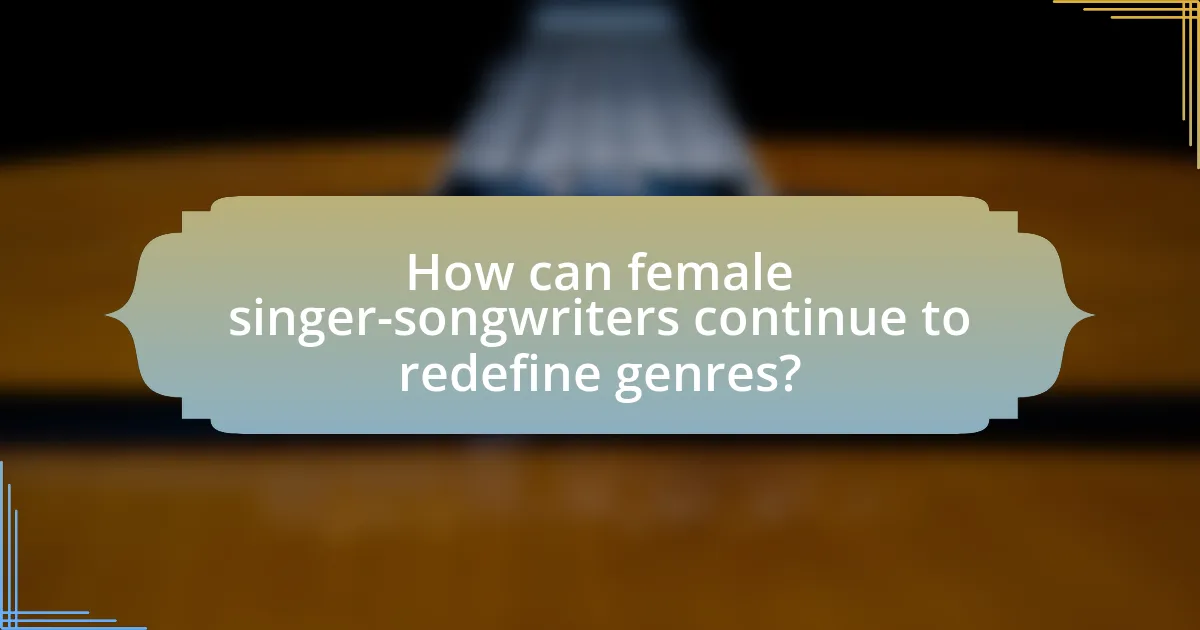
How can female singer-songwriters continue to redefine genres?
Female singer-songwriters can continue to redefine genres by blending diverse musical styles and incorporating personal narratives into their work. This approach allows them to challenge traditional genre boundaries and create innovative sounds that resonate with a wide audience. For instance, artists like Billie Eilish and Lizzo have successfully merged pop, hip-hop, and electronic elements, showcasing versatility and expanding genre definitions. Additionally, the rise of digital platforms enables these artists to reach global audiences, further influencing genre evolution through cross-cultural collaborations and experimentation.
What strategies can they employ to enhance their visibility?
Female singer-songwriters can enhance their visibility by leveraging social media platforms, engaging in collaborations, and participating in live performances. Social media allows them to connect directly with audiences, share their music, and build a personal brand; for instance, platforms like Instagram and TikTok have proven effective for artists to showcase their creativity and reach wider audiences. Collaborations with other artists can introduce them to new fan bases and create unique musical experiences, as seen with artists like Taylor Swift and Bon Iver. Additionally, live performances, whether in-person or virtual, provide opportunities to engage with fans and gain exposure, as evidenced by the rise of artists who gained popularity through online concerts during the pandemic.
How can social media be leveraged for greater reach?
Social media can be leveraged for greater reach by utilizing targeted advertising, engaging content, and strategic collaborations. Targeted advertising allows artists to reach specific demographics, increasing the likelihood of engagement; for instance, platforms like Facebook and Instagram offer tools to tailor ads based on user interests and behaviors. Engaging content, such as behind-the-scenes videos or live performances, fosters a connection with audiences, which can lead to higher shares and visibility. Strategic collaborations with other artists or influencers can also amplify reach, as seen when singer-songwriters partner with popular social media figures to tap into their follower base, effectively broadening their audience.
What collaborations can lead to genre-blending opportunities?
Collaborations between female singer-songwriters and artists from different genres can lead to significant genre-blending opportunities. For instance, when a pop singer-songwriter collaborates with a country artist, the resulting music can fuse elements of both genres, creating a unique sound that appeals to diverse audiences. Historical examples include the collaboration between Taylor Swift and Ed Sheeran, which combined pop and folk influences, resulting in chart-topping hits that showcased a blend of styles. Such partnerships not only expand the creative possibilities for the artists involved but also challenge traditional genre boundaries, as seen in the rise of cross-genre collaborations in the music industry.
What are the future trends for female singer-songwriters in the music industry?
Future trends for female singer-songwriters in the music industry include increased representation in diverse genres, greater use of digital platforms for distribution, and a focus on authenticity in songwriting. The rise of streaming services has enabled female artists to reach wider audiences without traditional gatekeepers, allowing for more genre-blending and innovative sounds. According to a 2022 report by the Annenberg Inclusion Initiative, female artists accounted for 22.5% of charting songwriters, indicating a growing presence that is likely to expand as industry dynamics shift. Additionally, social media platforms are empowering female singer-songwriters to connect directly with fans, fostering communities that support their artistic expressions and career growth.
How might technology influence their creative processes?
Technology significantly influences the creative processes of female singer-songwriters by providing them with innovative tools for music production, distribution, and collaboration. Digital audio workstations (DAWs) enable these artists to compose, record, and edit music from home, reducing the need for expensive studio time and allowing for greater experimentation. Additionally, platforms like SoundCloud and Bandcamp facilitate direct access to audiences, empowering singer-songwriters to share their work without traditional gatekeepers. Research indicates that 70% of independent musicians utilize social media for promotion, showcasing how technology enhances visibility and engagement with fans. This democratization of music creation and distribution fosters a diverse range of genres and styles, reflecting the unique voices of female artists in the industry.
What emerging genres could see a rise in female influence?
Emerging genres that could see a rise in female influence include indie pop, alternative R&B, and electronic music. Female artists are increasingly taking the lead in these genres, showcasing their creativity and unique perspectives. For instance, the rise of artists like Billie Eilish in indie pop and H.E.R. in alternative R&B demonstrates a significant shift towards female-driven narratives and sounds. Additionally, the electronic music scene has seen a surge of female producers and DJs, such as Charlotte de Witte and Alison Wonderland, who are reshaping the genre with their innovative approaches. This trend is supported by data indicating that female representation in music festivals and charts is steadily increasing, highlighting the growing impact of women in these emerging genres.
What practical tips can aspiring female singer-songwriters follow?
Aspiring female singer-songwriters should focus on developing their unique voice and style while actively networking within the music industry. Establishing a distinct artistic identity helps differentiate them in a competitive landscape, as seen with artists like Taylor Swift and Billie Eilish, who have successfully carved out their niches. Additionally, engaging with other musicians and industry professionals through social media platforms and local music events can lead to valuable collaborations and opportunities. Research indicates that networking significantly increases the chances of success in the music industry, as connections often lead to gigs, mentorship, and exposure.
How can they develop their unique sound and style?
Female singer-songwriters can develop their unique sound and style by experimenting with diverse musical influences and personal storytelling. By blending genres such as folk, pop, rock, and electronic, they can create a distinctive sound that reflects their individuality. For instance, artists like Fiona Apple and Billie Eilish have successfully integrated various styles, resulting in innovative music that resonates with audiences. Additionally, drawing from personal experiences and emotions in their lyrics allows these artists to establish a strong connection with listeners, further enhancing their unique identity in the music industry.
What resources are available for songwriting and production skills?
Resources available for songwriting and production skills include online courses, songwriting workshops, and production software. Platforms like Coursera and MasterClass offer courses taught by industry professionals, while local music schools often host workshops that provide hands-on experience. Additionally, software such as Ableton Live and Logic Pro X are widely used in the industry for music production, offering tools that enhance both songwriting and production capabilities. These resources are validated by their popularity among successful artists and their effectiveness in improving skills in the music industry.
